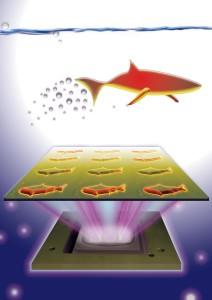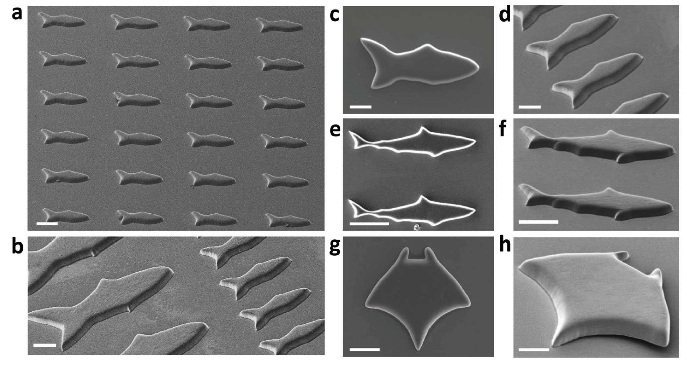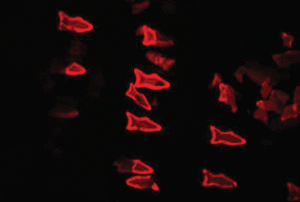 Biomimicry is nothing new. For years, scientists, engineers and designers have been studying nature and creating machinery, buildings, and other products based on the structures of plants and animals. For example, Velcro was invented by an engineer named George de Mestral, who based its design on the burrs he found stubbornly entangled in his dog’s fur. More recently, Branch Technology, a design firm based in Chattanooga, has been getting attention for their 3D printed structures based on their philosophy “Build Like Nature,” which takes its inspiration from natural cellular forms to create strong and lightweight walls. Biomimicry is a brilliant idea, really; after millenia of evolution, nature has a lot to teach us about what works the best, and what will last. It’s a nonstop learning process, and recently researchers have been using the shape and movement of fish for some incredible studies.
Biomimicry is nothing new. For years, scientists, engineers and designers have been studying nature and creating machinery, buildings, and other products based on the structures of plants and animals. For example, Velcro was invented by an engineer named George de Mestral, who based its design on the burrs he found stubbornly entangled in his dog’s fur. More recently, Branch Technology, a design firm based in Chattanooga, has been getting attention for their 3D printed structures based on their philosophy “Build Like Nature,” which takes its inspiration from natural cellular forms to create strong and lightweight walls. Biomimicry is a brilliant idea, really; after millenia of evolution, nature has a lot to teach us about what works the best, and what will last. It’s a nonstop learning process, and recently researchers have been using the shape and movement of fish for some incredible studies.
 In April of this year, we wrote about Maurizio Porfiri, the NYU Polytechnic professor and researcher who has been using 3D printed, robotic fish to study fear in live fish. Currently, he is working with a whole different area of science. Porfiri is using ionomers, which are polymers affected by electrical currents, to generate propulsion in submerged objects. The technology could potentially revolutionize the way ships and underwater electronics are designed.
In April of this year, we wrote about Maurizio Porfiri, the NYU Polytechnic professor and researcher who has been using 3D printed, robotic fish to study fear in live fish. Currently, he is working with a whole different area of science. Porfiri is using ionomers, which are polymers affected by electrical currents, to generate propulsion in submerged objects. The technology could potentially revolutionize the way ships and underwater electronics are designed.
“Imagine a sponge that is able to contract and expand based on an electric charge rather than hydration,” says Porfiri. “There are no moving parts, which make this concept very quiet. Also, the process can be reversed. Using eddy currents and vortices, any motion in a liquid could potentially charge sensors or be used in piezoelectronics.”
The technology can also allow for fish or other marine animals to be tagged with a sensor whose power is generated by the motion of the animal itself. This will enable scientists to more closely and efficiently study how the fish moves through the water, as well as the properties of the water.
“Imagine if a boat’s haul could flex,” Porfiri adds. “By tracking the pressures and energy in the water rather than on a rigid haul, we can determine what kind of energies could be generated by using this technology to transfer liquid movement to power the boat’s electronics. A flexible haul could also minimize the eddy currents and pressures, resulting in more efficient boat travel.”
Porfiri is not the only researcher currently working with fish, live or robotic, to study movement. A team of researchers at the University of California San Diego have developed robotic, 3D printed “swimming machines” that are designed in the shape of fish. Unlike Porfiri’s robotic fish, these ones are microscopic. The team, led by professors Shaochen Chen and Joseph Wang, 3D printed the fish, which are 120 microns long, 30 microns thick, and about as wide as a human hair, using a process called microscale continuous optical printing, which they developed in Chen’s lab and which we covered in detail earlier this year.
The research team has continued to work with these microfish to develop some astounding applications that could potentially solve major crises in the environment and in human health. Recently, the fish were successfully used as toxin sensors. The researchers incorporated polydiacetylene (PDA), a toxin-neutralizing nanoparticle, into the body of the fish, which were then put into a chemical solution. As the toxins in the solution bonded with the PDA, the fish lit up a fluorescent red. This is an exciting development, as the fish could potentially be used in the future to clean toxins from water, blood or other liquids. And that’s only one of their possible future applications.
“Another exciting possibility we could explore is to encapsulate medicines inside the microfish and use them for directed drug delivery,” says Jinxing Li, another co-author of the initial study.
The team also plans to use the technology to print other micro-creatures, such as sharks and rays. They also hope to experiment with microscopic birds in the future. You can see the fish swim below:
Subscribe to Our Email Newsletter
Stay up-to-date on all the latest news from the 3D printing industry and receive information and offers from third party vendors.
Print Services
Upload your 3D Models and get them printed quickly and efficiently.
You May Also Like
Consolidation in AM: How 2025 Is Shaping the Industry’s New Normal
The first half of 2025 has been marked by a clear shift in the additive manufacturing (AM) industry. Companies are no longer just focused on developing new tech by themselves....
Etsy Design Rule Change Reduces Selection of 3D Printed Goods
Online marketplace Etsy has implemented a rule change requiring all 3D printed goods on the site to be original designs. The update to the site’s Creativity Standards states, ¨Items produced using...
U.S. Congress Calls Out 3D Printing in Proposal for Commercial Reserve Manufacturing Network
Last week, the U.S. House of Representatives’ Appropriations Committee moved the FY 2026 defense bill forward to the House floor. Included in the legislation is a $131 million proposal for...
Transforming From Tourist to Native: Duro CEO Michael Corr Explains Why the Company Rebuilt its PLM Software on AI
In these early innings of the AI boom, many market analysts have expressed concern that AI spend has gotten too far ahead of the technology’s proven ability to deliver significant...


































